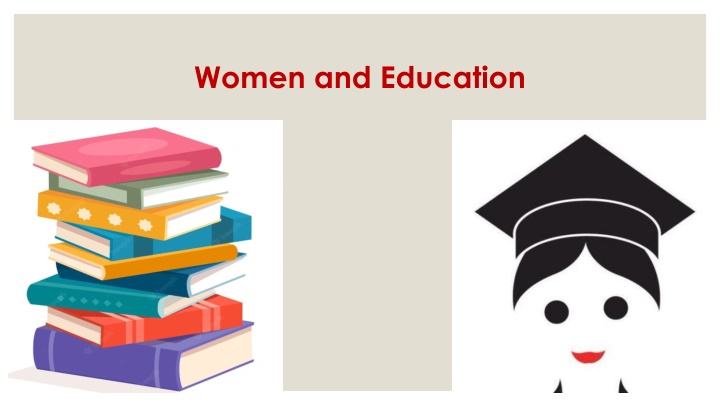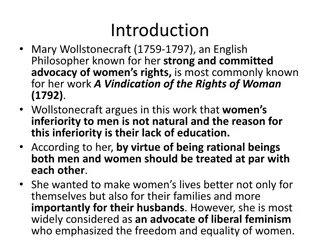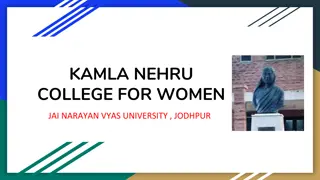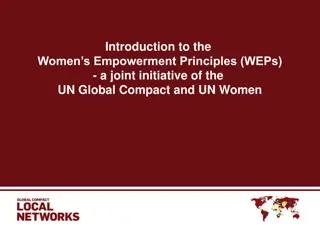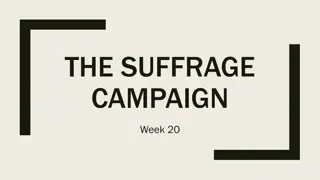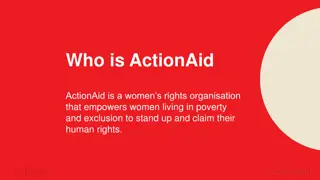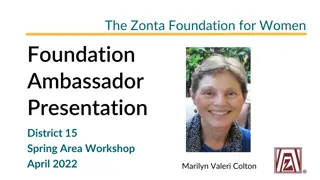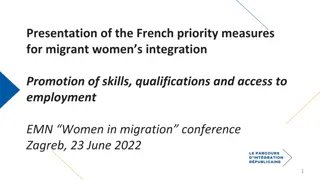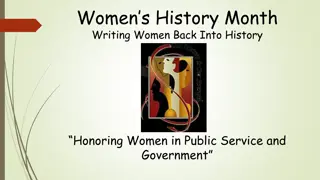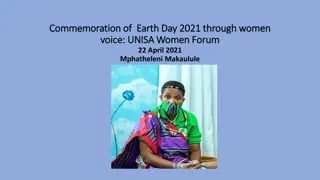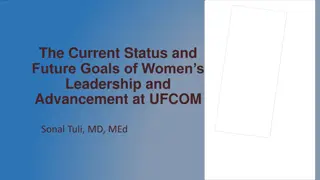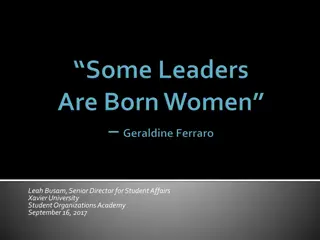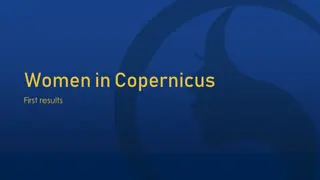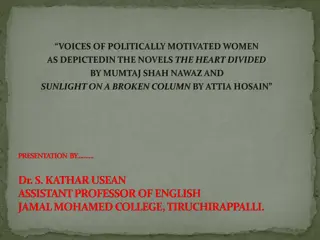Women and Education
Women's education in India has evolved over time, from the Vedic period to colonial India. Despite challenges faced in medieval times, efforts have been made to empower women through various forms of education. Education plays a crucial role in shaping the future of women and society as a whole, providing empowerment, independence, and opportunities for growth.
Download Presentation

Please find below an Image/Link to download the presentation.
The content on the website is provided AS IS for your information and personal use only. It may not be sold, licensed, or shared on other websites without obtaining consent from the author.If you encounter any issues during the download, it is possible that the publisher has removed the file from their server.
You are allowed to download the files provided on this website for personal or commercial use, subject to the condition that they are used lawfully. All files are the property of their respective owners.
The content on the website is provided AS IS for your information and personal use only. It may not be sold, licensed, or shared on other websites without obtaining consent from the author.
E N D
Presentation Transcript
Jawaharlal Nehru had once said- Educate a man and you educate one person. Educate a woman and youeducate the whole family.
Education Education is very essential for every one because it is the only education by which we can differentiate between human beings and animals. Education tells us that how can we live in a society that's why education is important for every one, for both men and women.
WOMEN EDUCATION Women education refers to every form of education that aims at improving the knowledge, and skill of women and girls. It includes general education at schools and colleges, vocational and technical education, professional education,health education,etc. Education for women is important because it makes them empowered and independent and helps them build self-confidence. It helps them dream and aim for a better future. It boosts their strength and gives them the spark to work harder for themselves and achieve their dreams.
History of Women Education in India .
WOMEN EDUCATION IN ANCIENT INDIA In the Vedic period women had access to education, but gradually they had lost this right. Indian scriptures Rig Veda and Upanishads mention about several Women sages and seers. Women enjoyed equivalent position and rights in the early Vedic era. However, after 500 B.C, the position of women started to decline.
Women Education in Medieval India The Islamic invasion played a vital role in restricting freedom and rights of the Women. Women education in medieval India further deteriorated with the introduction of Purdah system .Different customs and conventions of diverse religions like Hinduism, Islam, and Christianity further deteriorated the state of women in the country.
WOMEN EDUCATION IN COLONIAL INDIA Women education in Colonial India witnessed an essential expansion. Various movements were launched to make women of the country literate. Further more, this progress journey through the years and influenced the modern Indian education system.
Women Education in Modern India Women Education in Modern India is traced back to the years after the independence of India. In the present times, the government of India takes measures to provide education to all women of the country. Women literacy rate seemingly rose in the modern days. This has actually helped women to achieve top positions at work place and also at society. As per the Census, the total literacy rate of India is around 74.04%, out of which 82.14% compose the male literacy, and the female literacy rate counts up to 65.46%. Although the female literacy rate has seen a rise in the percentage level, it has not accomplished the goal which was set to have been achieved.
RECENT TRENDS IN EDUCATION The Constitution of India Guarantees free primary school education for both boys and girls up to age 14. Education in India plays a vital role in the overall development of the country. This proves that educated women promote education in their family. The government of India has recently launched the Saakshar Bharat Mission for Female Literacy, which aims to reduce female illiteracy.
Government Planning For women Education The National Plan of Action for Women(NPA) adopted in 1976 became a guiding document for the development of women till 1988 when a National Perspective Plan for Women was formulated. The National Perspective Plan for Women s Education (1988-2000) drafted by a Core-Group of experts is more or less along term policy document advocating a holistic approach for the development of Women. National Education Policy (1986)- In 1986, the government led by Rajiv Gandhi introduced a new National Policy on Education. The new policy called for special emphasis on the removal of disparities and to equalise educational opportunity, especially for Indian women, Scheduled Tribes (ST) and the Scheduled Caste (SC) communities.
University Education Commission (1948-49) The first committee for the most important education in independent India was the University Education Committee of 1948, Radhakrishnan, to report on the status of Indian university education and propose improvements and extensions. Desirable to adapt to the future and future requirements of the nation. National Committee on Women s Education (1958-59) Chaired by Durgabai Deshmukh the National Council of Women was established in 1958. The organization is set up to ensure the equal rights of women in society. The Committee advised that the establishment of educational equity between boys and girls educations be given first attention. Kothari Education (1964-66) National Education Commission (1964-1966), also known as Kothari Commission, was an ad hoc commission set up by the Government of India to examine all aspects of the educational sector in India, to evolve a general pattern of education and to advise guidelines and policies for the development of education in India.
Secondary Education Commission (1952-53) The Secondary Education commission known as Mudaliar Commission was appointed by the government of India in term of their Resolution to bring changes in the present education system and make it better for the Nation. Dr. A. Lakshmanswami Mudaliar was the Vice-Chancellor of Madras University. Hansa Mehta Report National council of women s education appointed Hansa Mehta Committee in 1962 to suggest measures for the improvement of women s education. Hansa Mehta demanded both equalities of status and opportunity for women with the delivery of proper social, economic, and political justice to them. Bhaktabashalm Report Bhaktavatsalam committee (1963) was appointed to study the problem of women s education. Both government and public should act jointly and proceed in a planned manner with regard to the education of girls. Reservation of seats for women in training institutions, provision of attractive pay, living accommodation, conveyance charge etc.
Necessity For Education of Women Empowerment of women Economic Increase in the Revenue of the Family Check on Social evils Part in Household Activities have proved that lack of education affects the general health of the family. Besides general health inculcating good moral values in her children would be one of the top priorities of any educated mother
CONCLUSION Women education should be given due importance in the present society. The education of girls and women is an integral part of national development. A well-educated woman provides the skills, knowledge, and self-assurance necessary to be a better mom, worker, and citizen. A well-educated woman will also be more productive and well-paid at work. Indeed, the return on investment in education is often higher for women than for males.
